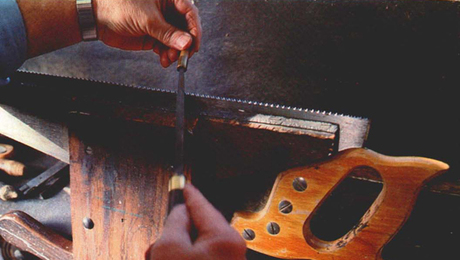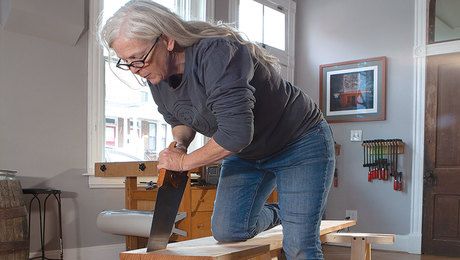Question 1:
From Rich:
A local woodworking professional elucidated the many virtues of the skew block plane, including that of fitting a tenon to a mortise. I purchased the plane and after a nearly a year of heavy use, am extremely satisfied.
Perhaps naively, I believe the skew plane obviates the need for a shoulder plane. Have you all used the skew block and if so, believe there to be a functional limitation when contrasted with a shoulder plane? I am not looking for an excuse to purchase a tool I do not own. 😏
Question 2:
From Ron:
I love the show and magazine! I’m considering my first real woodworking bench. I’m considering both purchasing, or building a custom one. My question is do you prefer round or square dog holes, and why? I’ve seen both style holes on popular, well regarded benches for sale, so it doesn’t seem like a universal preference.
Question 3:
From Devin:
I only flirted with panel saws before I got a table saw. I had thought I was pretty good with my hand saws but I have become obsessed with chair making and this has led to dust collecting on a lot of those saws. I have since gotten rid of my table saw (gasp!) for space saving measures. So I took out my panel saw and I noticed that whenever I pull the saw back, it wobbles back and Forth. For as much as I appreciate the great sound of a big saw wiggling, I wonder if that’s only good to the foley artists of the world.
Is this wobble an indication of bad sawing technique? In theory, would one not introduce any lateral movement, eliminating this phenomenon?
 |
Sharpening HandsawsIt’s a matter of knowing all the angles |
 |
Handwork: Build a saw benchMegan Fitzpatrick builds a pair of versatile saw benches to make it easier to crosscut and rip boards, drill, finish, help support workpieces, and more. |
Question 4:
From David:
My woodworking buddies often bounce questions and ideas off each other. My friend, Sri, sent this question around to a few of us. One of the group suggested that he send it into Shop Talk Live, but I don’t think he’s going to, so I’m sending it on his behalf.
“Gentlemen, a question about how to most easily get my work bench top level: my Sjoberg bench top is just about 1 and 1/4 inch thick. It has distinct concavity about 3/16 to 1/4 inch deep towards one end which has persisted a year at least now. I don’t think I can flatten the top by hand planing or with router sled for fear that the top will get too thin. Do you folks think I can pour table top epoxy / resin to fill in the depression instead? Essentially making the table top thicker with self leveling epoxy / resin and thus getting rid of the concavity?”
After some back and forth, the group thought that epoxy wouldn’t hold up very well to the rigors of a work bench. So, it was suggested that he pour a thin layer of epoxy, just to level it, and then screw a layer of MDF on top. We felt that although the MDF might not hold up over time, it would be easier (and cheaper) to replace than would epoxy. We also felt MDF would be a better choice than Baltic Birch plywood (which would dent more easily).
What are your thoughts about this, and how would you suggest flattening the workbench?
Every two weeks, a team of Fine Woodworking staffers answers questions from readers on Shop Talk Live, Fine Woodworking‘s biweekly podcast. Send your woodworking questions to [email protected] for consideration in the regular broadcast! Our continued existence relies upon listener support. So if you enjoy the show, be sure to leave us a five-star rating and maybe even a nice comment on our iTunes page.







